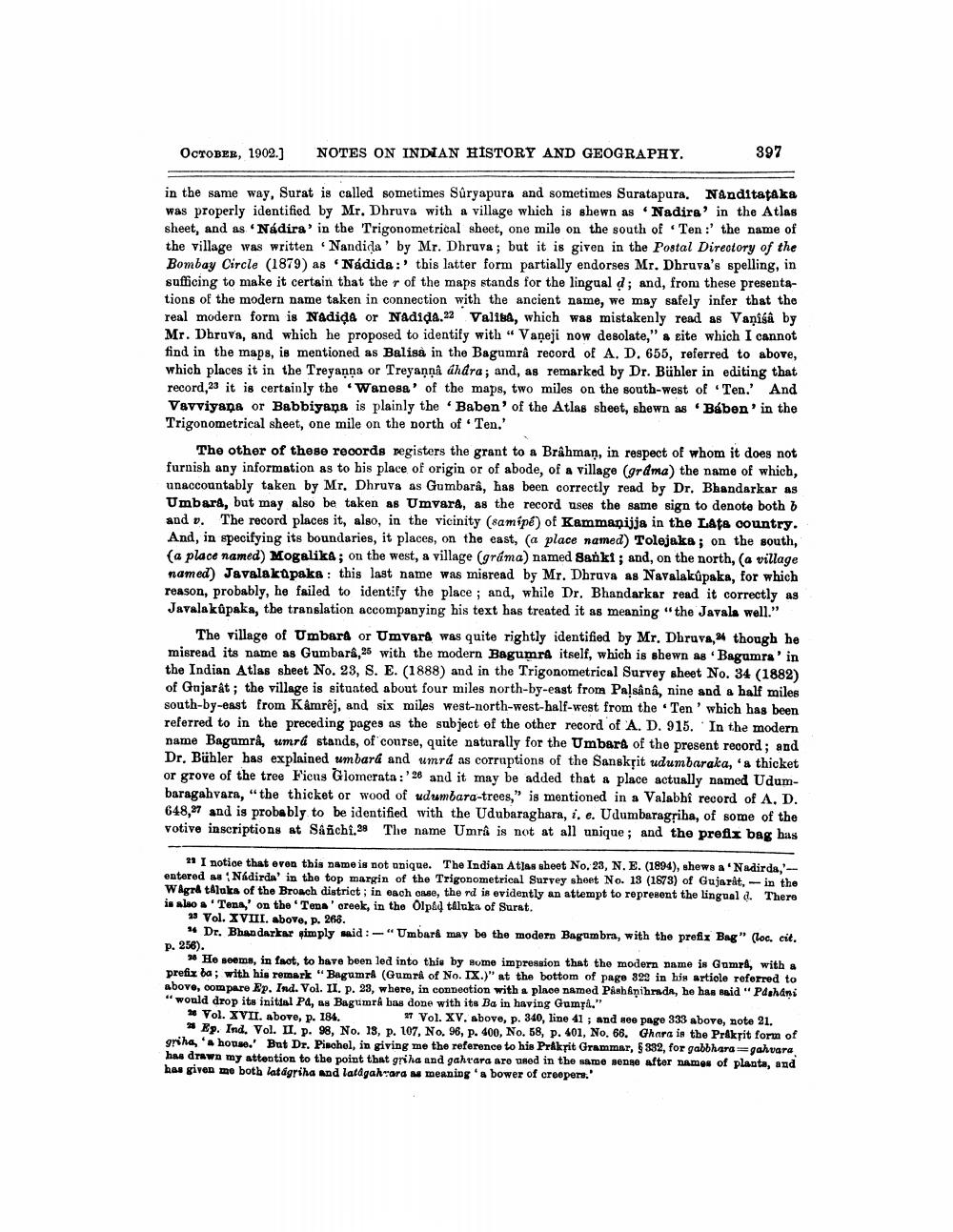________________
OCTOBER, 1902.)
NOTES ON INDIAN HISTORY AND GEOGRAPHY.
397
in the same way, Surat is called sometimes Suryapura and sometimes Suratapura. Nanditataka was properly identified by Mr. Dhruva with a village which is shewn as Nadira' in the Atlas sheet, and as Nádira' in the Trigonometrical sheet, one mile on the south of Ten :' the name of the village was written Nandida' by Mr. Dhruva; but it is given in the Postal Directory of the Bombay Circle (1879) as Nádida:' this latter form partially endorses Mr. Dhruva's spelling, in sufficing to make it certain that the r of the maps stands for the lingual d ; and, from these presentations of the modern name taken in connection with the ancient name, we may safely infer that the real modern form is Nadida or Nadida.22 Valita, which was mistakenly read as Vanisa by Mr. Dhruva, and which he proposed to identify with " Vaneji now desolate," site which I cannot find in the maps, is mentioned as Balisa in the Bagumrâ record of A. D. 655, referred to above, which places it in the Treyanna or Treyanná dhára; and, as remarked by Dr. Bühler in editing that record, 23 it is certainly the Wanesa' of the maps, two miles on the south-west of Ten.' And Vavviyana or Babbiyana is plainly the ‘Baben' of the Atlas sheet, shewn as Báben' in the Trigonometrical sheet, one mile on the north of Ten.'
The other of these records registers the grant to a Brahman, in respect of whom it does not furnish any information as to his place of origin or of abode, of a village (gráma) the name of which, unaccountably taken by Mr. Dhruva as Gumbara, has been correctly read by Dr. Bhandarkar as Umbara, but may also be taken as Umvard, as the record uses the same sign to denote both and v. The record places it, also, in the vicinity (samipe) of Kammaņijja in the Late country. And, in specifying its boundaries, it places, on the east, (a place named) Tolejaks; on the south, (a place named) Mogalika; on the west, a village (gráma) named Sankt; and, on the north, (a village named) Javalakapaka : this last name was misread by Mr. Dhruva as Navalakúpaka, for which reason, probably, he failed to identify the place; and, while Dr. Bhandarkar read it correctly as Javalakapaka, the translation accompanying his text has treated it as meaning "the Javala well."
The village of Umbará or Umvars was quite rightly identified by Mr. Dhruva, though he misread its name as Gumbara, 25 with the modern Bagumre itself, which is shewn as Bagumra' in the Indian Atlas sheet No. 23, S. E. (1888) and in the Trigonometrical Survey sheet No. 34 (1882) of Gujarat; the village is situated about four miles north-by-east from Paļsânâ, nine and a half miles south-by-east from Kamrêj, and six miles west-north-west-half-west from the Ten' which has been referred to in the preceding pages as the subject of the other record of A. D. 915. In the modern name Bagumra, umrá stands, of course, quite naturally for the Umbara of the present record ; and Dr. Bühler has explained umbard and umrá as corruptions of the Sanskrit udumbaraka, a thicket or grove of the tree Ficus Glomerata:'26 and it may be added that a place actually named Udumbaragahvara, "the thicket or wood of udumbara-trees," is mentioned in a Valabhi record of A. D. 648,27 and is probably to be identified with the Udubaraghara, i.e. Udumbaragriba, of some of the votive inscriptions at Sanchi.28 The name Umra is not at all unique; and the prefix bag has
n I notice that even this name is not unique. The Indian Atlas sheet No. 23, N. E. (1894), shews a Nadirda entered Nkdirda' in the top margin of the Trigonometrical Survey sheet No. 13 (1873) of Gujarit,- in the Wagra tAluks of the Broach district: in each me, the rd is evidently an attempt to represent the lingual &. There is also a 'Tena' on the 'Tena' creek, in the Olply taluka of Surat.
25 Vol. XVIII. above, p. 268.
4 Dr. Bhandarkar gimply said: -"Umbard may be the modern Bagumbra, with the prefix Bag" (loc. cit. p. 256).
" He seema, in foot, to have been lod into this by some impression that the modern name is Gumrl, with a prefix ba; with his remark "Bagumrl (Gumra of No. IX.)" at the bottom of page 329 in his article referred to above, compare Ep. Ind. Vol. II. p. 33, where, in connection with a place named Paahaņihrada, he has said " Pdshani " would drop its initial Pd, as Baguimr& bas done with its Ba in having Gumpa." * Vol. XVII. above, p. 184.
97 Vol. XV. above, p. 340, line 41 ; and see page 333 above, noto 21. » Ep. Ind. Vol. II. p. 98, No. 13, p. 107, No. 96, p. 400, No. 58, p. 401, No. 66. Ghara is the Prikrit form of griha, 'house.But Dr. Pischel, in giving me the reference to his Prikrit Grammar, 6332, for gabbharagahuara, has drawn my attention to the point that griha and gahrara are used in the same senge after names of planta, and has given me both latagriha and latgah aram meaning a bower of creepers.'




